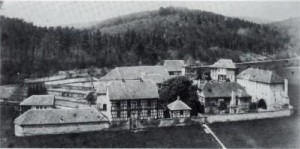 Georg Ludwig Rexroth built a water-powered hammer mill in Elsavatal in the Spessart valley in 1795. There is a pond there which is still called the “Höllhammer” pond after the ironworks.
Georg Ludwig Rexroth built a water-powered hammer mill in Elsavatal in the Spessart valley in 1795. There is a pond there which is still called the “Höllhammer” pond after the ironworks.
Archaeologists from the area say that there was a hammerworks there already when Rexroth arrived — probably before 1702. There was water to power a mill and forests to produce charcoal, and the land was not suited to agriculture. The family living in the castle at the time seems to have had trouble running the hammerworks, however, and both the castle and the hammerworks were in ruins when Rexroth bought (or possibly leased — the records are unclear) the property in 1795.
Rexroth and his son had one goal: to make an efficient hammerworks. They succeeded, developing seven forges powered by four water wheels. The hammerworks brought in expert craftsmen and workmen from all over Europe. These foreign workers were given homes, goats, and share in the new community. Rexroth built roads as well, giving the hammerworks a great advantage when the French Revolution and the Napoleonic wars drove demand for their products.
By the 1830s, there was a community there of about 600 people, with 100 people working in the hammerworks. Archaeologists say that the workers were well compensated and well treated, with good wages and a wine allowance. A school for the children of the workers was established.
The hammerworks closed on August 8, 1891, and the Rexroth family moved on to other pursuits (they had opened a new iron foundry some years before in another part of Germany). However, the emphasis on efficiency as continue to this day.
